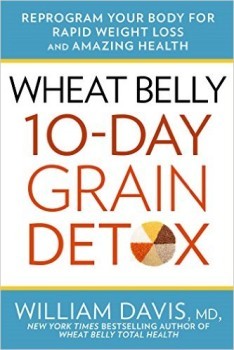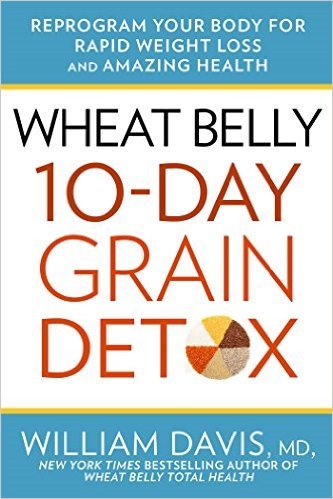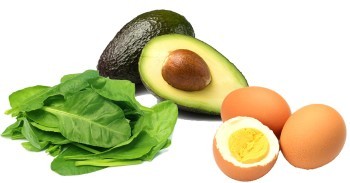William Davis's Blog: Dr. Davis Infinite Health Blog, page 117
November 6, 2015
A mother of 9 slam-dunks the Wheat Belly lifestyle

Patricia, a mother of 9 children, shows what the Wheat Belly lifestyle can accomplish for mothers’ hips and buttocks, as well as health.
“I am nearly 50 and mother to 9 incredible children raging in age from 20 to 4. I am healthier and leaner now than when I was 13. 125 pounds was the thinnest I knew myself to be. However, regardless of my seemingly healthy nutrition, I was making two crucial mistakes: wheat/grains and sugar.
“Throughout my adult years, I struggled with weight and, as I aged, joint pains. I got as high as 165 pounds on my 5’2″ frame. Now I have come to learn that my ideal weight is 110 pounds and that surely has been surprising to me. But the way my body feels without the extra weight is phenomenal. I am passing 2 photos of me taken in 2011 and 2015 because hopefully they can inspire people who may be considering or struggling with ditching grains and sugars once and for all.”
“The most significant and profound improvement has come to my 20 year old son who suffered from severe eczema. The answer all along for him was wheat. However, our entire family lost loads of inflammation and weight. We have never been healthier.”
We can’t see Patricia’s face, of course, but the view from the back would cause me to guess her age to be much younger, perhaps even her 30s. While we usually see the striking facial changes that reversed inflammation and weight loss yields, here we see what it looks like from a different perspective.
Patricia tells me that she is planning on sharing the photos and some stories about the rest of her family, as they are all following the Wheat Belly lifestyle, also with wonderful results. That’s going to be very interesting!
The post A mother of 9 slam-dunks the Wheat Belly lifestyle appeared first on Dr. William Davis.
November 5, 2015
1-Minute Blueberry Ice Cream
A recipe from Wheat Belly 10-Day Grain Detox.
 I recognize that our effort to get away from processed food products and return to real, single-ingredient foods involves time and effort. Here is a way to make your own ice cream that requires almost no effort. Note that, for this time-saving shortcut to work, the blueberries must be frozen. And, as always, adjust the quantity of sweetener to the tastes of your family, depending on how far along on the wheat-free process they have progressed.
I recognize that our effort to get away from processed food products and return to real, single-ingredient foods involves time and effort. Here is a way to make your own ice cream that requires almost no effort. Note that, for this time-saving shortcut to work, the blueberries must be frozen. And, as always, adjust the quantity of sweetener to the tastes of your family, depending on how far along on the wheat-free process they have progressed.
Add a green, unripe banana to the mix if you want to add about 27 grams of prebiotic fibers to the treat.
Makes 4 (1/2-cup servings)
1 cup heavy whipping cream or canned coconut milk
1 cup frozen blueberries
Sweetener equivalent to 1 tablespoon sugar
1/2 teaspoon vanilla extract
In a blender, combine the whipping cream or coconut milk, blueberries, sweetener, and vanilla. Blend until the mixture thickens.
Per 1/2-cup serving: 229 calories, 1 g protein, 7 g carbohydrates, 22 g total fat, 14 g saturated fat, 1 g fiber, 23 mg sodium

The post 1-Minute Blueberry Ice Cream appeared first on Dr. William Davis.
November 4, 2015
Wheat Belly Grain Detox on Dr. Oz

I recently made my fourth appearance on the Dr. Oz Show. In this episode, we discuss how/why wheat and grains underlie inflammation and fatigue. Rebecca came on the show after having undergone the Wheat Belly 10-Day Grain Detox and shared her wonderful story of obtaining dramatic relief from fatigue, now enjoying high energy. We then show viewers how to make the Wheat Belly All-Purpose Baking Mix and another participant in the Wheat Belly 10-Day Grain Detox, Elaine, shows us some of the wonderful dishes she made with the mix while losing 49 pounds in the 7 months since she tried the Detox.
Part 1: Grains, inflammation, and fatigue
Part 2: Making the Wheat Belly All-Purpose Baking Mix
If you’d like to view the prior Wheat Belly episodes of the Dr. Oz Show, you will find them archived in both the Wheat Belly Blog Media page and the Dr. Oz Show website (enter either “Dr. William Davis” or “Wheat Belly” into the search bar).
The post Wheat Belly Grain Detox on Dr. Oz appeared first on Dr. William Davis.
You may be only DAYS away from a health transformation

Abigail shared her early experience starting the Wheat Belly lifestyle:
“I’m 7 days strong and down 8.4 pounds as of my 5th day [top photo]. I’m a full-blown Wheat Belly freak now and I’m loving every minute.”
Abigail is down more than a pound a day, facial edema and redness receding rapidly and dramatically—reflecting that inflammation and inflammatory edema (water-retention) are staging a rapid retreat. Yes, Abigail will lose inches off her waist and other areas, dropping many dress sizes over the next few months. But it’s inflammation and inflammatory edema dissolving away that accounts for such dramatic early changes.
Obviously, we can view Abigail’s facial inflammation/edema receding, but we can’t view all the other areas of her body experiencing the same improvements, such as her gastrointestinal tract, her bloodstream, her respiratory and sinus systems, her joints, and her brain. If inflammation in its varied and complex forms underlies chronic conditions such as coronary heart disease, diabetes, cancer, and dementia, then a dramatic reduction in inflammation, you’d predict, would reduce the potential for all such diseases.
Yes, white flour products are awful foods that fuel inflammation. But whole grain products do, also. Just because whole grains have more fiber and B vitamins does not mean that all the inflammatory power of grains is now gone–they are most definitely still there. A multi-grain loaf of bread, for instance, still contains the gliadin protein, wheat germ agglutinin, amylopectin A, and allergens (e.g., gamma gliadins, alpha-amylase and trypsin inhibitors) that trigger inflammation body-wide.
The post You may be only DAYS away from a health transformation appeared first on Dr. William Davis.
November 2, 2015
Shopping List – Wheat Belly 10-Day Grain Detox
 The countdown is on! Only a few days until Wheat Belly 10-Day Grain Detox is in bookstores all over the US.
The countdown is on! Only a few days until Wheat Belly 10-Day Grain Detox is in bookstores all over the US.
If you’ve preordered, you can get ready for success! Here’s the shopping list of commonly used ingredients that will get you off the ground running with the day-by-day menu plan in the Wheat Belly 10-Day Grain Detox!
Almond meal/flour
Almond milk, unsweetened
Baking powder (aluminum-free)
Baking soda
Cauliflower
Cheeses (preferably full-fat, organic)
Chia seeds
Chocolate—100% chocolate, 85% cocoa or greater
Chocolate chips, dark
Cocoa powder, unsweetened
Coconut flour
Coconut milk—canned for thickness, carton for drinking
Coconut, shredded and unsweetened; coconut flakes
Dried fruit, unsweetened
Extracts—natural almond, coconut, vanilla, and peppermint
Flaxseeds, preferably ground golden
Ground nut meals—ground almonds, pecans, walnuts, hazelnuts
Insulin powder
Nut and seed butters—almond butter, peanut butter, sunflower seed butter
Nuts—raw almonds, pecans walnuts, pistachios, hazelnuts, Brazil nuts; chopped walnuts or pecans for baking
Oils—extra-virgin olive, coconut, organic butter, ghee, avocado, flaxseed, walnut, extra-light olive, non-hydrogenated lard or tallow
Seeds—Raw sunflower, raw pumpkin, sesame, and chia
Shirataki noodles (in the refrigerated section)
Spaghetti squash
Sweeteners—liquid stevia, powdered stevia (pure or with inulin, not maltodextrin), monk fruit, powdered erythritol, xylitol
Zucchini
The post Shopping List – Wheat Belly 10-Day Grain Detox appeared first on Dr. William Davis.
Kitchen Clean Up – Wheat Belly 10-Day Grain Detox
 If you’ve preordered the Wheat Belly 10-Day Grain Detox, you don’t have to wait to get started. In one week you’ll get a day-by-day menu plan with everything you need to jump start your weight loss and rapidly improve your health. Start preparing today by cleaning out your kitchen and setting yourself up for success on your detox.
If you’ve preordered the Wheat Belly 10-Day Grain Detox, you don’t have to wait to get started. In one week you’ll get a day-by-day menu plan with everything you need to jump start your weight loss and rapidly improve your health. Start preparing today by cleaning out your kitchen and setting yourself up for success on your detox.
First step: clear your kitchen of all obvious wheat and grain sources. Take a look at the list below and pull these items out of your kitchen. If your family isn’t on board for the detox, make sure to create a cabinet or shelf and space in the refrigerator especially for your detox food, so you won’t be tempted to “cheat” and reignite your body’s addiction to wheat and grain.
Making the break abruptly and cleanly is very important for success.
Clean your cabinets of these foods (donate or throw away!):
Wheat-based products: breads, rolls, breakfast cereals, pasta, orzo, bagels, muffins, pancakes and pancake mixes, waffles, doughnuts, pretzels, cookies, crackers.
Bulger and triticale (both related to wheat).
Barley products: barley, barley breads, soups with barley, vinegars with barley-malt.
Rye products: rye bread, pumpernickel bread, crackers.
All corn products: corn, cornstarch, cornmeal products (chips, tacos, tortillas), grits, polenta, sauces or gravies thickened with cornstarch, corn syrup, high-fructose corn syrup, breakfast cereals.
Rice products: white rice, brown rice, wild rice, rice cakes, breakfast cereals.
Oat products: oatmeal, oat bran, oat cereals.
Amarath.
Teff.
Millet.
Sorghurn.
Then eliminate hidden sources by reading labels.
Eliminate hidden sources of grains by avoiding the processed foods that fill the inner aisles of the grocery store. Almost all of these are thickened, flavored, or textured with grain products, or grains are added as cheap filler and/or appetite stimulants.
Living without grains means avoiding foods that you never thought contained grains, such as seasoning mixes bulked up with cornstarch, canned and dry soup mixes with wheat flour, Twizzlers, soy sauce, frozen dinners with wheat-containing gravy and muffins, and all breakfast cereals, hot and cold. (You will find lists of the hidden aliases for wheat and corn, in particular, that can be found in so many processed foods in Appendix B of Wheat Belly 10-Day Grain Detox.)
This does not mean you will never have a crunchy breakfast “cereal” again or a salad topped with delicious dressing. You will learn to either make your own versions with no unhealthy grains to booby-trap your lifestyle or to identify the brands that have no grains or other unhealthy ingredients added.
The post Kitchen Clean Up – Wheat Belly 10-Day Grain Detox appeared first on Dr. William Davis.
A toast to wine

Thank goodness: Wine is a safe haven for those of use who wish to be wheat- and grain-free.
We all know that single-ingredient foods that occur in nature are wheat-, grain-, and and gluten-free: cucumbers, olives, basil, cranberries, ribeye steak, flounder, etc. It’s when humans get involved and add ingredients derived from wheat (as well as from barley, rye, and oats) to human-processed foods that wheat and other grain components enter the picture.
The vast majority of wines are made without exposure to anything wheat, grain, or gluten. Rare exception: Because of a push to get away from animal-derived clarifying agents, such as gelatin derived from cows (due to bovine spongiform encephalopathy, or mad cow disease), winemakers have sought non-animal sources of clarifying agents. Clarifying agents are used to make wines clearer and more appealing to the consumer. Clarification removes residual grape skin, seeds, or stem debris; dead yeast cells; and various proteins. Among the most popular clarifying agent choices are bentonite, potassium sorbate, and sodium benzoate. However, some winemakers have lately turned to gluten or deamidated gluten for wine clarification. Thankfully, this remains an uncommon practice. I believe it will become less common as more and more of us raise a stink about grain/gluten exposure in ANY food.
The available scientific data on gluten content in wines in which gluten has been used for clarification suggest that virtually none makes its way to the finished product you pour. There are three studies I’m aware of that have examined whether gluten used in the clarification process make their way to the wine itself. Here is one such study. Obviously, if you consume a rare rogue wine that provokes a gluten response, don’t drink it again, then be sure to tell the winemaker about it. Also, come back here and tell us about it.
So the overwhelming majority of wines are wheat-, grain-, and gluten-free safe choices for alcoholic beverage: chardonnay, pinot grigio, viognier, vinho verde, merlot, cabernet sauvignon, garnacha, malbec, rioja . . . along with all the other wines produced from other varietals and blends. More so than any other class of alcoholic beverage, wines are therefore our first choice–even when you toast with wine!
Now, vodka is another story . . .
The post A toast to wine appeared first on Dr. William Davis.
Wheat Belly works for Iveta in Lithuania

I love hearing about Wheat Belly experiences outside North America. (Wheat Belly is published in 34 countries around the world.) Iveta from Lithuania shared her story and photos:
“My name is Iveta. I’m from Lithuania. I really love your book and Wheat Belly lifestyle. We have your book translated to the Lithuanian language. This book made a huge impact for me.
“I had ulcerative colitis for almost 3 years and, since I’m wheat-free, I feel great. Here is my photo, you can see a little difference (on the left side before wheat free lifestyle and on the right side I’m now.)
“I’m wheat-free nearly 2 months. I find it hard to eliminate all grains, but I definitely will try.”
Reversing ulcerative colitis is a huge accomplishment for Iveta. Not only is she spared from the pain, diarrhea, and bleeding that accompany the disease, she is also freed from the nasty drugs prescribed for this condition, as well as the markedly increased risk for colon cancer–all gone. Going grain-free will help eliminate the chance that other grains and their closely-related proteins won’t reactivate the disease. And, Iveta, please be sure to address vitamin D, omega-3 fatty acids, and cultivation of bowel flora, all of which help the intestines heal further and make it less and less likely that you will ever suffer a relapse. (Discussed in detail in the Wheat Belly Total Health book and summarized in this Wheat Belly Blog post.)
And isn’t it wonderful that, in parallel with her receding colitis, that you can also witness the reversal of inflammation on her face? See the reduction in facial swelling such as that in her cheeks? You can appreciate that Iveta looks different now that she has removed the inflammatory effects of wheat.
The post Wheat Belly works for Iveta in Lithuania appeared first on Dr. William Davis.
October 28, 2015
New research clinches it: non-celiac gluten sensitivity is real

At the United European Gastroenterology Week 2015 in Barcelona, Spain, Dr. Giovanni Barbara from the University of Bologna reported exciting new findings concerning so-called non-celiac gluten-sensitivity, NCGS, and irritable bowel syndrome, IBS.
They studied the blood levels of zonulin protein in each of these conditions and in celiac disease. Readers of the Wheat Belly books may recall that Dr. Alessio Fasano and his team, while working at the University of Maryland, deciphered the complex pathway by which the gliadin protein of wheat, rye, and barley triggers release of zonulin protein into the blood. Zonulin also plays a crucial role in modulating intestinal permeability and initiating autoimmune conditions such as rheumatoid arthritis, type 1 diabetes, and multiple sclerosis, and may also play a role in triggering asthma. Higher levels of zonulin protein in the bloodstream suggest increased levels of abnormal intestinal permeability and greater potential for an autoimmune condition. It also suggests that the gliadin protein of grains underlies this effect, since so few other factors increase zonulin levels.
By measuring the blood levels of the zonulin protein as a marker for the degree of intestinal permeability, Barbara and his team found that the highest zonulin levels were found in the people with celiac disease (0.033 ng/mg), levels in people with NCGS (0.030 ng/mg) were only slightly less, and lower in IBS (0.012 ng/mg). The mean level in healthy volunteers with none of these conditions was 0.007 ng/mg. It means that the level of abnormal intestinal permeability triggered by the gliadin protein is nearly identical in people with celiac disease and NCGS. It also means that people with IBS do not just have a “functional” disorder, i.e., a condition with symptoms but no identifable abnormality, but do indeed have some degree of abnormal intestinal permeability over and above that of people without IBS.
Oddly, though not surprisingly, Dr. Barbara stated: “Hopefully, our work will lead to new diagnostic and therapeutic strategies for patients with these and possibly other autoimmune conditions.” In other words, measuring zonulin levels in other conditions may turn up abnormal levels of intestinal permeability in those conditions, as well, and that opportunities may open for new drug development.
If you ask me, if the whole mess was started by ingesting the gliadin protein of wheat, rye, and barley, well, why not just stop eating wheat, rye, and barley?
By the way, the above graphic is an illustration showing the structure of the gliadin protein and what Dr. Fasano calls “gliadin motifs” that are responsible for its varied and destructive effects: Mapping of α-gliadin motifs exerting cytotoxic activity (red), immunomodulatory activity (light green), zonulin release and gut-permeating activity (blue), and CXCR3-IL-8 release in CD patients (dark green). It’s a darned nasty protein with a host of health-damaging effects not restricted to celiac disease, but a protein we are told to eat more of every meal, every day.
The post New research clinches it: non-celiac gluten sensitivity is real appeared first on Dr. William Davis.
October 27, 2015
Choose Real, Single-Ingredient Foods – Wheat Belly 10-Day Grain Detox
An excerpt from the Wheat Belly 10-Day Grain Detox! Preorder now to take advantage of a free gift from Rodale Books plus enter for a chance to win a delicious bundle of food from the Wheat Free Market in my preorder sweepstakes.
– – – – –
 An avocado, intact in its skin, can be chosen with confidence, as no food manufacturer added grains to it. Eggs in their shell likewise. In other words, foods left more or less intact and unmodified by a food manufacturer should top your list of foods to choose from that are safe for your empowering grain-free lifestyle. Avocados and whole eggs are real—not fake, multiple-ingredient marketing conceptions of some food manufacturer—there’s no chance of exposure to grains, added sugars, high-fructose corn syrup, hydrogenated oils, or other no-no’s.
An avocado, intact in its skin, can be chosen with confidence, as no food manufacturer added grains to it. Eggs in their shell likewise. In other words, foods left more or less intact and unmodified by a food manufacturer should top your list of foods to choose from that are safe for your empowering grain-free lifestyle. Avocados and whole eggs are real—not fake, multiple-ingredient marketing conceptions of some food manufacturer—there’s no chance of exposure to grains, added sugars, high-fructose corn syrup, hydrogenated oils, or other no-no’s.
You will find the majority of real, single-ingredient foods in the produce section, butcher counter, and dairy refrigerator. Depending on the layout of your supermarket, you may have to venture into those hazardous internal aisles for some of your baking supplies, spices, and nuts, but do so while ignoring all the packaged, processed, glitzy, eye-catching products.

Avoiding foods with labels simplifies the task of label reading, Cucumbers, spinach, and pork chops, for example, don’t come with labels (expect to display weight and date). Avoiding labels means you’ll be buying foods in their basic, least modified forms. Sure, the pork chops were sliced from a larger piece of the meat from the animal, but it should not have been changed in any other way.
This simple policy of choosing real, single-ingredient foods has served prior Wheat Belly followers well, served our detox panelists well, and will serve you well, particularly as you are learning to navigate the lifestyle at the start.
Choosing real, single-ingredient foods that are nourishing and don’t yield land mines in your Wheat Belly 10-Day Grain Detox means enjoying unlimited quantities of vegetables, meats, eggs, raw or dry-roasted nuts and seeds, fats and oils, cheeses, and many sugar-free beverages.
The post Choose Real, Single-Ingredient Foods – Wheat Belly 10-Day Grain Detox appeared first on Dr. William Davis.
Dr. Davis Infinite Health Blog
Recognize that this i The insights and strategies you can learn about in Dr. Davis' Infinite Health Blog are those that you can put to work to regain magnificent health, slenderness, and youthfulness.
Recognize that this is NOT what your doctor or the healthcare system provides, as they are mostly interested in dispensing pharmaceuticals and procedures to generate revenues. The healthcare INDUSTRY is not concerned with health--you must therefore take the reins yourself.
Dr. Davis focuses on:
--Real, powerful nutritional strategies
--Addresing nutrient deficiencies unique to modern lifestyles
--Deep insights into rebuilding the microbiome disrupted by so many modern factors
Follow Dr. Davis here and on social media and you can witness the extraordinary successes people enjoy on his programs. ...more
- William Davis's profile
- 160 followers



